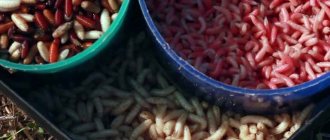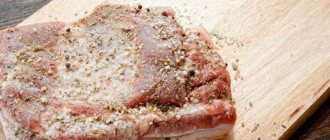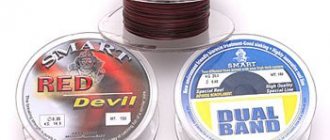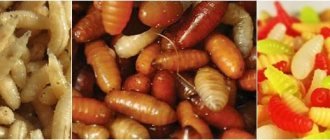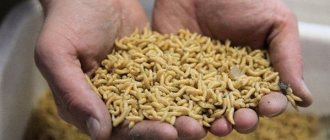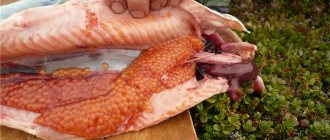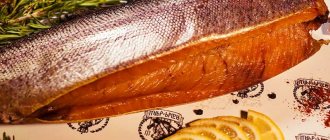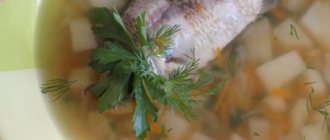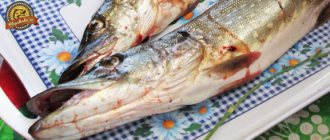Maggots are the larvae of blowflies that are used as food for aquarium fish, exotic pets and birds. But the most famous use of this insect is as a fishing bait. This bait is in no way inferior, and perhaps is somehow better than earthworms. It is not always possible to buy it immediately before leaving for nature. Therefore, the topic of how and where to store maggots for fishing is of interest to many lovers of this exciting hobby.
Description of maggot
According to their color, the larvae are divided into white, cream and slightly yellowish. Their main purpose is fishing bait for representatives of the carp and perch families.
In nature, the larvae, whose length ranges from 4 to 12 mm, feed on stale foods (mainly meat or rotten plants). In laboratory conditions, a nutrient medium is created for them, a mixture of sugar and starch.
If the conditions in which the larva is located are favorable, when it reaches a size of 10 mm, it begins to transform into a pupa, and after 10–15 days into a fly. In unfavorable conditions, the insect hibernates (its life processes freeze).
If the larva is exposed to heat, under the sun's rays, it can harden very quickly: literally in 30 minutes. In conditions of elevated temperature, the process of its transformation into a fly sometimes takes only 3 days. Therefore, it is very important to know at what temperature to store maggots.
Different types of larvae have specific life cycles. At the same time, the longest life span is in young individuals with a dark spot near the head. Representatives of the red pink species, reaching a size of 1 cm, are also considered very tenacious. In a cold place, they remain active for up to six months.
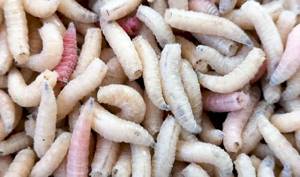
Why is it important to store maggots correctly?
For future fishing to take place, you need to know one important rule. Namely, how to store maggots at home. After all, room temperature and humidity are ideal conditions for pupation of fly larvae. This is a reliable fact. At very hot temperatures, for example in the summer sun, this process can speed up several times. As a result of this, the larva hardens in literally half an hour. In elevated temperatures, the bait will turn into a full-fledged fly in just 3 days. Therefore, in order for the maggot to retain its original shape, it is necessary to adhere to several recommendations. More on this below.

Under what conditions should it be stored?
Storing maggots at home should occur at a temperature of about 0°C.
- Higher rates lead to a change in the state of the larvae, which will begin to transform into flies.
- At sub-zero temperatures, on the contrary, they will freeze and die.
Larvae that were hatched in spring or summer do not turn into pupae for 2 to 3 months. And so that they remain viable in winter, they are bred no earlier than autumn.
Before storing maggots in the refrigerator, they are washed and dried well.
How to store maggots and worms
The capacity of the cage depends on how lively and fresh the maggots and worms arrive for fishing. Often these baits are stored for several days before fishing. How to preserve worms and maggots? Ensuring the best bite begins long before arriving at the pond. Along with selecting suitable equipment components, you need to take care of ensuring the most comfortable conditions for the bait.
Reseeding maggots
At high temperatures, maggots die or pupate, turning into casters. Therefore, they need to be stored at low temperatures, preferably in the refrigerator, where the temperature is +4 degrees C.
But first they need to be prepared.
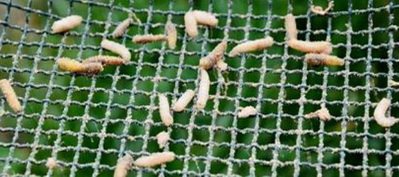
Maggots are usually sold with sawdust. Some larvae are too lethargic or not alive. The purchased maggot needs to be reseeded. It is placed on a sieve with a corresponding cell above the container. The most vigorous larvae will pass through the sieve. Everything that remains on the sieve goes to waste.
If there is a lot of sawdust, then the maggots must first be sifted out from the sawdust on a sieve with a mesh size of up to 4 mm.
Preservation in cornmeal
It is better to mix the sifted out lively larvae with a small amount of corn flour. It dries the larvae well and takes away the smell. Also, cornmeal does not need to be removed before adding livestock to the bait. But you can, of course, add fresh sawdust.

You cannot leave maggots in a closed container - they need to be provided with drying and better air access. Therefore, they are poured into a fairly spacious cotton bag, which is tightly tied. In this dry form, the larvae can be kept in the refrigerator, and then arrive for fishing, where they are poured into containers on the fishing table or added to bait.
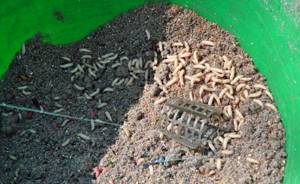
How to store for a long time
But these recommendations are not entirely suitable for storage for too long - several months. And for fishermen, such a need arises regularly. After all, many people especially don’t have time to go to sales points or raise larvae every month. Once stingy at the beginning of autumn, many want the maggot to remain alive and healthy by the beginning of winter - for an excellent bite on the first ice...
- Fresh maggots should be cleaned. To do this, it is sprinkled with fine pine sawdust, which is also disinfected. In a few days, all the excess will come out of the maggot. There should be enough sawdust to keep the larvae dry. The sawdust is blown off the dried and cleaned maggots and the larvae are transferred.
- The maggots are sprinkled with starch or baby powder (talcum powder), and placed in a food-grade plastic container in a layer of no more than 10 cm. In this form, they are placed in the refrigerator for long-term storage (+4 +8 degrees). The larvae stop moving, and this is normal; after heating they become active again.
- During storage, the larvae need to be stirred every 2 to 4 days so that they do not get wet and, most importantly, are saturated with oxygen. It is better to make a lot of very small holes in the lid...
It's better to feed the worms
Worms also quickly lose vitality if not properly maintained. Sluggish worms need to be fed - put cucumber slices or potato slices on them, this will return their fighting qualities. You can use other vegetables and fruits.
Content
You need to store worms in spacious bags made of loose fabric that allows enough oxygen to pass through, and filled with a large amount of garden soil. These bags should only be placed in the shade, in the coolest place, preferably on clean, unpainted concrete, which perfectly absorbs excess moisture.
In a slightly cooled state with plenty of soil and oxygen, worms can live for quite a long time. But they need to be periodically mixed with the ground so that they crawl and clean themselves.
With lively bait on the hook, the chances of catching fish increase significantly.
Cold storage
During the warm season, storing maggots at home is possible on the refrigerator shelf. The worms are washed and dried, and then placed in a clean container. You can store maggots in any food container with a tight-fitting lid.
Before storing maggots in the refrigerator, cover them with flour or bran. You can also use non-coniferous sawdust or fine clean sand. The substrate used for storing larvae should be replaced every 2 weeks.
The optimal storage temperature for maggots is +3°C - +5°C. Under such conditions, they fall into a state of suspended animation and persist for 2 to 3 months. If you open a container with worms during storage, you will notice that they have become much less mobile than they were before. Even if the larva seems motionless, this is normal: after a couple of minutes in the warmth, it will wake up and begin to move.
But if more than 5 minutes pass and the larvae remain motionless, this is an indicator of their improper preparation for storage. Also, maggots that are subjected to emergence from suspended animation several times will not survive.
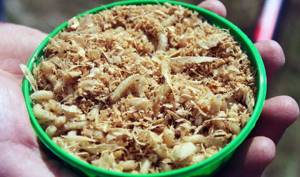
How to store live bloodworms at home
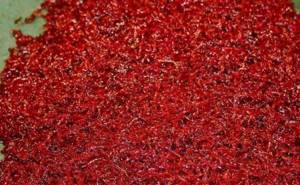
The old grandfather's method - I immediately sweep away the stocking in the toilet tank. Despite all the main advantages (temperature, water change), there is too much bait waste. I'm guilty of containing disinfectant additives in the form of hypochlorite in the water.
I buy bloodworm larvae in the store and buy one glass at a time. The fact is that smaller quantities are stored worse.
Having once adopted a method from an aquarist, I still use it. At the time of writing, I was surfing the Internet and discovered that the method is already in use, which means there is no reason to force you to read it. It’s better to watch a video about storing bloodworms alive.
The only thing I want to draw your attention to is water. I don't take water from the tap. In winter, there is nothing difficult about collecting snow and letting it melt. Without containing disinfecting impurities, melt water has a better effect on the storage of larvae.
A couple of days before fishing, I place bloodworms in potatoes. I cut the tuber lengthwise and cut out a hole. Potatoes cut crosswise have a smaller volume and the bloodworms are contained in a deeper layer. The cut lengthwise allows the larvae to experience less discomfort.
I took a handful out of the jar, placed it in the potatoes and in the refrigerator. Before fishing, I move it to the bloodworm.
In one of the issues of “Fishing in Rus',” magazine editor Vladimir Balovnev described his method of storing bloodworms.
1. I take a foam plastic egg cassette. 2. Cut off the flat top cover. 3. Using plasticine, I increase the height of the partitions between the cells so that water does not overflow from cell to cell. 4. I put a live bloodworm passed through a sieve into each cell with a small mound and let it settle more tightly - this is 5-10 minutes. 5. I fill each cell with a small amount of water so that it just saturates the bloodworms. 6. I put the cassette filled with bloodworms into a regular bag and pull the top of the film so that it does not touch the bloodworm. 7. I place this “incubator” horizontally in the freezer. 8. Usually in the spring I make 3-4 such cassettes, which last me until the end of July. 9. One portion (cell) is enough even with active biting for the whole day. 10. Before leaving for fishing, I shake out one frozen portion of bloodworms, wrap it in a cloth in several layers and put it in a jar with a screw-on lid. The volume of the jar is almost 200 g. Bloodworms in such an improvised “thermos” do not thaw for more than 4 hours. 11. When fishing, I pour water into a jar and put a bloodworm ice in it. 12. I don’t change the water during the day, even in the heat. Bloodworms in water do not turn black and retain their original color, with the exception of live movement. 13. If you don’t tell the fish that you are catching frozen bloodworms, then it will never guess about it and will bite you for your sweet soul. 14. At the end of July - beginning of August, on Sunday, I go to the canal in Dubna for any competitions and whine to the athletes after the finish for the remaining large bloodworms, fortunately the people are always very responsive. I bring him to my dacha and the process repeats from point No. 1. I have enough bloodworms until the end of the summer season, considering that during the season I go fishing 60 to 75 times and always only with frozen bloodworms. If you need smaller portions, then the mold for making ice for cocktails or whiskey, which comes with each refrigerator, is quite suitable.
Winter storage
When the external temperature does not exceed +3°C - +5°C, maggots can be stored on the balcony. When it drops, the container with bait is transferred to the coolest place in the apartment. In the absence of a refrigerator, this can be a special warmer (container) made independently in the garden.
An improvised container for storing maggots is made as follows:
- A pipe with a small diameter (8 - 10 cm) is sealed on one side.
- The closed side of the container is placed in open ground to a depth exceeding its freezing level (more than 1 meter).
- A cylinder is made of tin, the diameter of which is slightly smaller than that of a pipe that is buried in the ground. This will be the main container for storing maggots.
- The lid for the container is made of foam plastic or other material with a tight fit to the edges of the improvised container.
After the container for storing maggots is ready, the larvae are poured into it, lowered into the pipe and closed tightly. To make it convenient to take out the container, you need to take care of holders with ropes in advance.
Storing maggots underground can last a very long time. Before going fishing, they take out the required amount, and continue to store the remaining worms in the “heatbox”.
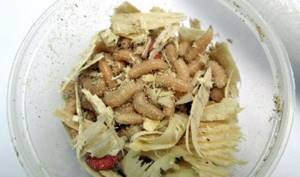
Boiled maggot bait
Some fishermen use boiled fly larvae as bait. They are poured with water, brought to a boil and lightly simmered over low heat until they become translucent. After this, the question of how to store maggots after heat treatment becomes relevant.
The boiled larvae are slightly dried and then placed in a canvas bag, which is taken to a cold place. It is possible to sprinkle the bait with flour, but this is not a requirement.
It is very important that boiled maggots are stored in the cold (balcony in winter, refrigerator shelf in summer). At elevated temperatures it will deteriorate very quickly.
Coloring the larvae
To give boiled maggots some color, you can use not only natural dyes, but also decoctions of various vegetables. For example, beet juice will give the worms a red tint, and a decoction of onion peels will give them a rich orange hue.
You can make sure that the larvae get a certain color even at the growth stage by feeding them food of a certain color. For example, using cottage cheese to feed them leads to a change in color to white, and boiled egg yolk in the diet of maggots will make their color golden.

Feeding maggots
Live maggots become pets because they need to be fed every day. A big plus is that they eat any food, so leftover food and food waste can pass for food.
You can also use a delicacy - cottage cheese. Most fishermen believe that it not only gives the larvae a white tint, but also makes them more attractive to predatory fish.
If the budget does not allow you to allocate delicacies for feeding “pets”, ordinary beets will do, they will give a scarlet tint and increase the nutritional value.
Fishing storage
Outdoors in the heat, you can store maggots in a tightly closed glass container. At the same time, it is covered with grass, or buried in coastal sand so that moisture does not end up inside the jar.
Any organic debris can serve as food for the larvae. But after feeding them, you need to close the lid tightly so that the nimble insects do not crawl away in different directions.
If this happens during winter fishing, so that the worms do not freeze, keep the container with them in your bosom. But in summer it is enough to send them to the coolest shaded place.
When the larvae pupate (the transition period is called caster), they are filled with water to prevent them from turning into flies. Caster (if it is no longer possible to stop the process) can also be used as bait or bait for fish.
General recommendations for storing maggots
In this case, there are certain criteria. When deciding how to store maggots, you should know that the optimal temperature for this is considered close to 0 °C. In other cases, negative phenomena are observed. Namely:
- At temperatures above +10 °C the larva gradually begins to pupate.
- Below 0 °C it dies.
It is also important to rinse and dry the newly found maggot. This will contribute to its longer storage.
Experienced fishermen often hatch maggots themselves. They already know the condition. It lies in the fact that if the larvae are hatched in spring or summer, their pupation can be prevented for 2-3 months. If you do this in the fall, then you don’t have to worry about changes in the shape of the maggot throughout the winter. This is important to know.
Types of feeding maggots
Agile white worms in the active phase require regular feeding. But there is no need to worry about their diet. They are practically omnivorous, but most of all they will be happy with meat scraps, cottage cheese and even vegetables (ordinary beets will do).
The task of keeping maggots alive at home is not as difficult as it might seem. The simple recommendations given in this article will help even a novice fisherman use this bait all year round. At the same time, the larvae will not lose their initial qualities and will not require much attention.
